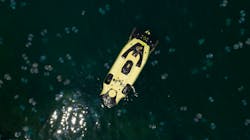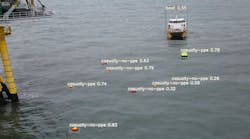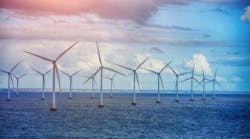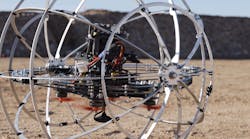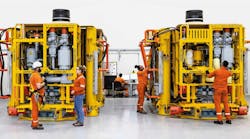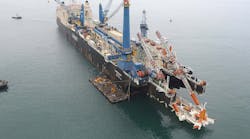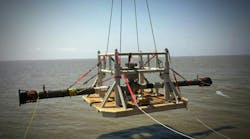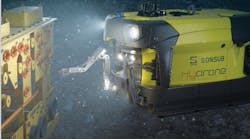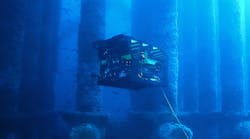Editor's note: This Subsea Systems column first appeared in the July-August 2023 issue of Offshore magazine. Click here to view the full issue.
By Ariana Hurtado, Editor and Director of Special Reports
Artificial intelligence (AI) has improved subsea robotics, specifically underwater drones, for autonomous navigation, monitoring, detection and inspection.
“Present and future offshore fields (oil and gas and renewables) are characterized by an increased operational complexity and an increased need for advanced life of field (LoF) services, capable of guaranteeing safety and productivity of fields while minimizing operational costs and carbon footprint,” Mauro Piasere, Saipem's COO Robotics and Industrialized Solutions, told Offshore. “The recent technological developments are now enabling the development of advanced, highly autonomous subsea robots, recognized by the whole offshore industry as a new paradigm in performing LoF services.”
Saipem’s FlatFish technology is designed to be a high-tech, low-cost system for operators to assist them during the life of complex subsea fields and efficiently manage related operational risks. FlatFish is the conjunction between the subsea robotics program of Shell (with research institute Senai Cimatec) and Saipem’s Hydrone program. With the aim of offering services such as demanning of offshore operations, automation of inspection tasks and de-risking of projects via a subsea resident drone able to be at site at a moment’s notice, Saipem has been working on the FlatFish project since March 2018 via an exclusive license granted to develop the technology and qualify it for offshore commercial application.
Over the last five years, Sonsub, Saipem’s center of excellence for subsea robotics, underwater technologies and digital solutions, has been working on an AUV capable of doing what the company says are “unprecedent tasks.”
“Saipem’s experience as an EPCI contractor for the energy industry has introduced a unique approach to the development of the [AUV] drones so that when it comes to local inspections calling for autonomous operations and onboard real-time data processing, Hydrone can offer an unrivalled set of capabilities,” Piasere said. “FlatFish and Hydrone-R can autonomously inspect an asset while being in DP mode and moving along a 3D path also along the column of water. By doing so, inspections of risers are now accessible and represent a unique survey capability across the industry.”
FlatFish features an advanced AI-based control system capable of goal-driven autonomous mission execution with real-time decision-making. It also offers navigation features, such as hovering, pipeline and riser tracking, combined with modular inspection capabilities enabled by edge computing, vision and through-water communication systems allowing 3D reconstruction and data harvesting of subsea nodes. It also provides tracking of the mooring lines of floating wind farms and the whole spectrum of inspections related to the power cables, along with structural monitoring.
The remotely controlled subsea resident autonomous underwater drone is rated to 3,000 m water depth and can operate up to 48 hours. It is able to inspect the entire underwater domain, including pipelines, structures, risers, mooring point and dynamic cables. FlatFish was designed to offer reduced inspection costs (no/limited vessel support) and safer intervention (unmanned offshore operations). It also provides a reduced environmental impact, with a 90% CO2 emission reduction compared to conventional ROV services.
“FlatFish’s capabilities have been recently demonstrated in two deepwater pilot projects offshore Brazil where inspections of live assets including christmas trees, manifolds, flowlines and risers have been executed in almost 1,800 mwd with the support of Shell and Petrobras, achieving the ready for commercialization stage for main key functions,” Piasere said.
Both projects are part of an R&D program of ANP, the Brazilian National Agency of Petroleum, Natural Gas and Biofuels. The aim was to qualify the drone to conduct vessel-free inspections for monitoring and maintenance of the subsea infrastructure. Sonsub has led the activities over a 12-month period, with a subsequent development phase of additional technological features currently under negotiation among the parties.
Another milestone regarding the FlatFish was the recently announced award of a contract by Petrobras for the development and testing of an autonomous subsea inspection robotic solution, which will be based on Saipem’s fleet of underwater drones, starting from the FlatFish, as well as the qualification of related autonomous drone-based services, enabling future inspection contract options offshore Brazil.
In addition to oil and gas applications, FlatFish can be used for within the renewables sector, particularly floating wind farms and floating solar projects. In addition, it can be deployed during ultradeepwater operations as part of deepsea mining activities particularly in the early phase of mapping and just after mining operations for compliance and seafloor preservation tasks.
Editor’s note: Read the AUV/ROV project roundup article in this issue.
